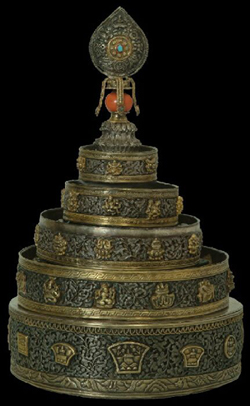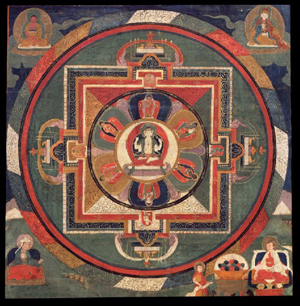Buddhist practice and Buddhist art have been inseparable in the Himalayas ever since Buddhism arrived to the region in the eighth century. But for the casual observer it can be difficult to make sense of the complex iconography. Not to worry—Himalayan art scholar Jeff Watt is here to help. In this “Himalayan Buddhist Art 101” series, Jeff is making sense of this rich artistic tradition by presenting a weekly image from the Himalayan Art Resources archives and explaining its role in the Buddhist tradition. This week we explore mandalas.
Himalayan Buddhist Art 101: Mandalas
 Mandalas are important in Tibetan Buddhism. In Vajrayana Buddhism there are two principal types of mandalas, which are quite different from each other and have completely different purposes and functions.
Mandalas are important in Tibetan Buddhism. In Vajrayana Buddhism there are two principal types of mandalas, which are quite different from each other and have completely different purposes and functions.
The first type is the “mandala offering,” which is a symbolic offering of the entire universe made by Buddhist practitioners. The offering is presented to past and present religious teachers, buddhas, and deities. A specific ritual object called a mandala plate is used for this offering, although anything flat and clean is also acceptable. Mandala plates are filled with rice, grains, or precious jewels and are arranged in multi-tiered levels. They are also commonly kept on a permanent shrine. Shrine mandalas are constructed from a flat metal mandala plate and then three or four rings of metal are placed above, often engraved, embossed, or repousse worked, and topped with a small replica of a heavenly palace or a dharma wheel.
The second type is the “deity mandalas,” which are described in Tantric literature as a circular diagram, architectural, highly technical, and precise, representing the entire idealized universe of a deity, entourage, palace, and surroundings. They are created from colored sand, painted on cloth, on the ceilings of temples, or as wall murals, fashioned from metal, textiles, wood, stone, and sometimes colored threads.
Deity mandalas are an essential component of Tantric meditation. In Buddhist Tantra there are two stages of meditation which work together on the path to reaching enlightenment in a single lifetime: generation stage yoga and perfection stage yoga. Generation stage yoga is also called “deity yoga.”
 Deity mandalas in art are visual representations of the principal meditation object—the central figure—along with the entourage, palace, and surrounding environment. In deity yoga mandalas can be both front visualization or self visualization, which means that the meditator visualizes either the entire complex creation of deities and palace a few feet in front of them, or self visualizes oneself as the deity, entourage, and entire palace and surroundings. There are many, many different types of deity mandalas.
Deity mandalas in art are visual representations of the principal meditation object—the central figure—along with the entourage, palace, and surrounding environment. In deity yoga mandalas can be both front visualization or self visualization, which means that the meditator visualizes either the entire complex creation of deities and palace a few feet in front of them, or self visualizes oneself as the deity, entourage, and entire palace and surroundings. There are many, many different types of deity mandalas.
It is important to know that mandala paintings are never used as the object of visualization. They are not placed in front of the meditator and used as the focus—the external object of meditation. This has often been a common misconception in the West since before the arrival of Buddhism.
—Jeff Watt
Click on Image 1 (Mandala Offering, from Tibet House New Delhi) and Image 2 (Avalokiteshvara Mandala) to find out more about them.
Suggested Links:
Mandala Main Page
Mandala Technical Glossary
Mandala Offerings
“Tantric Art: Maps of Enlightenment: An Interview with Jeff Watt” (Tricycle, Spring 2005)